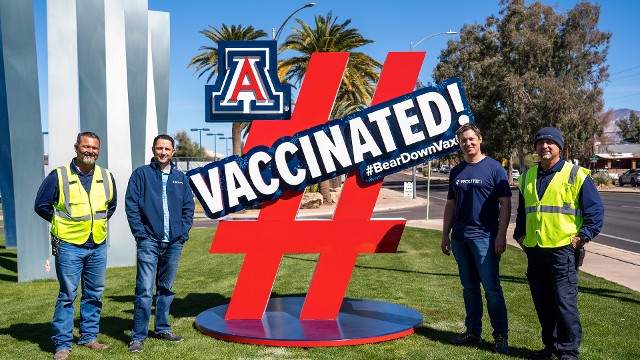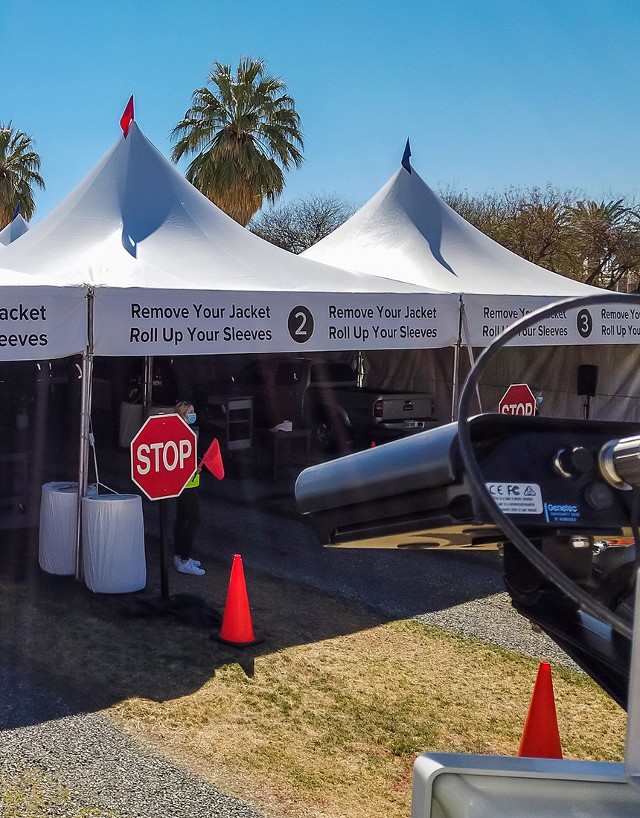University of Arizona
Driving up vaccination POD efficiency with ALPR traffic
The Situation
Established in 1885, the University of Arizona (UArizona) is a public land-grant university in Tucson, Arizona, United States. Today, the university enrolls about 46,900 students and employs 15,500 staff and faculty in 20 different colleges and schools. In early 2021, the UArizona had been chosen as one of the main points of distribution (POD) in Tucson.
Aiming to get the university vaccination POD up and running quickly, key departments joined forces and set up an incident command team. Soon enough, residents were booking appointments online and lining up their vehicles at the University of Arizona Mall, the university’s main entrance, for their scheduled vaccination.
While the vaccine roll-out was underway, questions came up about how long it took for people to get through the POD and what the maximum capacity could be with their multi-lane setup. To gather data, volunteers began asking drivers to send text messages as soon as they entered and exited the vaccine POD. Hiring personnel to manually track traffic data would be too costly, and the team wondered if they could fully trust the information. Manual tracking traffic data would also be too costly, and the team wondered if they could fully trust the data. After all, long and mundane manual tasks are often prone to human error.

The Situation
Established in 1885, the University of Arizona (UArizona) is a public land-grant university in Tucson, Arizona, United States. Today, the university enrolls about 46,900 students and employs 15,500 staff and faculty in 20 different colleges and schools. In early 2021, the UArizona had been chosen as one of the main points of distribution (POD) in Tucson.
Aiming to get the university vaccination POD up and running quickly, key departments joined forces and set up an incident command team. Soon enough, residents were booking appointments online and lining up their vehicles at the University of Arizona Mall, the university’s main entrance, for their scheduled vaccination.
While the vaccine roll-out was underway, questions came up about how long it took for people to get through the POD and what the maximum capacity could be with their multi-lane setup. To gather data, volunteers began asking drivers to send text messages as soon as they entered and exited the vaccine POD. Hiring personnel to manually track traffic data would also be too costly, and the team wondered if they could fully trust the information. Manual tracking traffic data would also be too costly, and the team wondered if they could fully trust the data. After all, long and mundane manual tasks are often prone to human error.
The Solution
“We were discussing the progress of going gateless in one of our parking garages. We had already heard about how ALPR could be used for tolls and monitoring traffic flow, and we were eager to see if the ALPR cameras could help us automatically track vehicles entering and exiting our POD. Plus, we already had an established relationship with Genetec [and Route1], so we took the opportunity to reach out,” explains Jim Sayre, Executive Director of Parking & Transportation Services at the University of Arizona.
With the vaccine POD already up and running, the university was eager to implement the new ALPR subscription service and pair it with new insights and functionality. Because the solution is hosted in the cloud, the university didn’t need to purchase expensive or manage a new IT effort.
On the day of installation, Route1 and UArizona teams rolled up their sleeves and got to work. Mounting poles and power for the cameras had been set up in advance, so they gathered before the POD opening hours to get the AutoVu ALPR cameras up and running.
According to Elton Crawford, Assistant Director of Operations – Parking & Transportation Services at the University of Arizona, “We had our first camera up within 20 minutes…. And though we planned to finish by 10 am before the first vaccination appointments, everything was done 10 minutes before cars began lining up at 9 am. We were fully operational from day one.”
“Since Route1 already established a great working relationship with PTS on some recent parking enforcement applications, the integrator brought more than expertise to the table. Route1 knew the customer well and dug deeper to understand what the team wanted to achieve and how they could best help them meet their goals.”
– Genetec Case Study: University of Arizona
Considerations
Intuitive data insights
The team regularly monitors live traffic data. They also examine trends, comparing what’s happening right now to yesterday, or the current and previous week.
Easy visual reporting
“Everything is displayed on a visual graph within Security Center. This helps us immediately identify if there are random delays or potential issues that we need to investigate,” said Sayre.
Flexible mobile viewing
When out in the field, the UArizona team is taking advantage of the Security Center Mobile app to check data. They can retrieve and email reports, see when a camera falls offline, or verify peak hours.
HIPAA compliance
As a healthcare-related operation, the University of Arizona made sure the Genetec solution would comply with all Health Insurance Portability and Accountability Act (HIPAA) requirements.
“Time and time again, Route1 has demonstrated their ability to go the extra mile, and deliver new value and innovation for our joint customers. This is another shining example of their ability to help organizations use their physical security systems as strategic tools, and go beyond traditional applications to deliver more value.”
– Stephan Kaiser, AutoVu™ General Manager at Genetec, Inc.
The Results
When someone drives through the POD’s main entrance, an AutoVu ALPR camera captures a timestamp of the vehicle. Two more cameras capture the vehicle entering and exiting the vaccination tunnel, and then a final camera track the vehicle leaving the site. This allows for four unique time stamps on every vehicle that comes through the POD. The Travel Times module within Security Center then analyses all ALPR data and delivers insights the team can act on.
One insight discovered was that various team leaders had different processes for appointment check-ins. When those processes were standardized, they could consistently get vehicles through the POD faster. Another insight was that on certain days of the week cars took longer to get through the POD. Those days often had mostly new volunteers. Following this, experienced personnel was always onsite to assist newbies and keep the throughput of vehicles high.


The Results
When someone drives through the POD’s main entrance, an AutoVu ALPR camera captures a timestamp of the vehicle. Two more cameras capture the vehicle entering and exiting the vaccination tunnel, and then a final camera track the vehicle leaving the site. This allows for four unique time stamps on every vehicle that comes through the POD. The Travel Times module within Security Center then analyses all ALPR data and delivers insights the team can act on. According to Tony Busseri, President & CEO of Route1, “We all came together to build a solution that would not only offer valuable insights about their POD operations but would also be affordable and easy to set up.”
One insight discovered was that various team leaders had different processes for appointment check-ins. When those processes were standardized, they could consistently get vehicles through the POD faster. Another insight was that on certain days of the week cars took longer to get through the POD. Those days often had mostly new volunteers. Following this, experienced personnel was always onsite to assist newbies and keep the throughput of vehicles high.